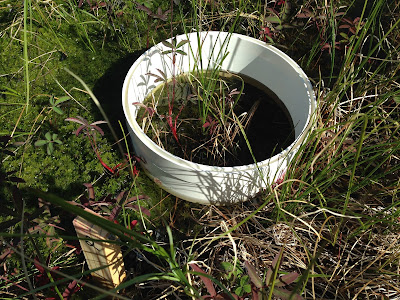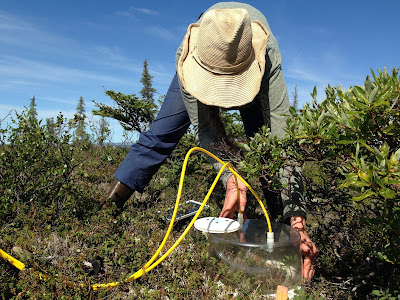Amy Breen
International Arctic Research Center
Alaska Climate Science Center
Scenarios Network for Alaska & Arctic Planning
University of Alaska Fairbanks
Last week, I traveled to Nome to meet with middle school
students at the Anvil City Science Academy charter school. My aim was to
establish a researcher-teacher partnership with their middle school science
teacher as part of The Arctic in the Classroom Project led by ARCUS (Arctic
Research Consortium of the United States). The Alaskan Arctic is a science-rich
region with stunning natural landscapes, ecosystems, and people. Arctic
science, however, is not always well communicated to the people that live within
the region. Their project facilitates citizen science and community-based
monitoring collaborations between students, teachers, and researchers in Arctic
communities.
 |
| Nome Public High School and Middle School |
The school was kind enough to offer housing at the Nome
public schools for
my two-night visit. My flight arrived on Wednesday night. After taking a cab to
pick up my rental truck, I met my teacher partner Tammie Holt for the first
time. Tammie is a new teacher at the school and arrived at the end of the
summer from Colorado with her husband. She was late meeting me due to a last
minute offer of fresh caught Bering Sea crab and halibut from her neighbor that
she could not pass up, and I certainly could not fault her on that decision. She
gave me the room key and we talked about the logistics of meeting the next two days
with her students. I slept surprisingly well in the single dorm style
accommodations.
Our plan for the visit was to introduce myself, my background,
and research interests on the first day, and then to do a field trip with the
students the following day. The field trip was work that I would have otherwise
done independently to collect seed from several tall shrub species for an
experiment to begin during the 2017 growing season. The NGEE Arctic Shrub Team
will stratify the seed, germinate it in the greenhouse this spring, and then
outplant seedlings into the field on the Seward Peninsula. We will set up two
experiments to test: 1) whether tall shrubs can survive beyond the northern
limit of shrubline in the Arctic with supplemental warming, and 2) whether
shrubs survive best in undisturbed tundra or tundra disturbed by wildfire in
different age fire scars. Our expectation is the shrubs will have higher survivorship
in the warmed and disturbed settings, showing that temperature limits shrub
distributions and that wildfire disturbance facilitates shrubification.
 |
| Student collecting seed from an alder shrub |
The first morning, I met with two separate science classes
that each convened for 50 minutes. We began with introductions from all of the
students which included their sharing of what they enjoy most about science. I
told them my story of how I became a scientist and we talked about different options
to work as a scientist in the Arctic. I shared a set of slides mostly comprised
of photos to provide a glimpse of the work that I do teaching an Arctic field
course and as a field biologist, leaving time at the end for more of a Q &
A with the students where they could ask me questions. I got several great
questions such as, “How long was I in school to become a researcher?” and
“Where do I see myself in 5 years? Will I still be doing the same sort of
work?”
My cleverest moment of the discussion was when I remembered
the 2015 film, “The Martian,” (and book by Andy Weir) in which the main
character is not only an astronaut, but also a botanist and engineer, who is
inadvertently left behind during a Mars mission and has to grow his own food to
survive. It was a great illustration of why studying plants, or botany, is a
worthy career track for a scientist – including a reference to the more applied
work of agriculturists. I also made the analogy of the character being a field
biologist, although rather than studying earth system science, his field site
was on Mars. We then became engaged in a lively discussion about whether
astronauts will actually travel to Mars in our lifetime. There were several
students that were quite adamant there is a high probability that the first
human will step on Mars in the next twenty years. Although we were not
specifically talking about Arctic science, it was still great to be able to
reference a botanist as the main character in a high profile Hollywood movie.
Interestingly, President
Obama set a goal to send humans to Mars by the 2030s, and return them safely to
Earth, just a few days later.
That afternoon, I scouted the area around the Nome High
School and Middle School for a good place for the field trip. We were limited
to within one mile of the school because the students would be on foot. The
only tall shrub population I found within that restriction was Siberian Alder.
The distance from the school to the collection site was just right at the
one-mile limit on a maze of 4-wheel drive dirt roads toward Anvil
Mountain. I was fearful we would lose a
student on the approach so I set out to mark the route as I would for a running
or biking race – with orange flagging and spray paint arrows on the road
surface.
The next morning both classes (40 students) met together for
the field trip so that we would have almost 2 hours to travel by foot to the
field site and make our seed collections. I brought in alder twigs to show the
students the plant in its winter state after its leaves had dropped. Alder is a large shrub up to 2 m tall in the
tundra. The flowers are borne on catkins
and the female catkins mature in late fall in clusters of 3-10 that resemble
small pinecones. We reviewed the methods
by which I wanted students to collect the seed.
In short, each student was to collect 10-15 catkins per plant from a
unique individual. The catkins were to
be stored in paper lunch sacks and labeled appropriately. If nothing else, I
wanted the students to learn the importance of detailed labels in the field and
lab. I showed the students how to fold the bags to assure the seeds were
contained and to affix the end of the bag with a piece of masking tape. We did a quick head count and we were off.
 |
| Looking back at the group of 40 students from the front of the classroom. |
I led the parade of students from the school to the
collection site. Mrs. Holt followed behind in her vehicle as a safety
precaution. Little did I know, many of
the students ran cross-country and the roads I had chosen to follow were well
known from their after school practice.
Before I knew it, students were running ahead following the marked
course. I started running with them as well, as I didn’t want the crowd to get
too far ahead. I may or may not have impressed the students with my scientific
pursuits, but I did impress several with my running ability. I am pretty sure
they expected to drop me within the first quarter mile.
 |
| Students traveling to the field site on foot. |
Once we got to the alder population I had chosen, I had the
group in the front wait while I ran back to gather the line of students
stretched out as they were walking at different paces behind the lead
group. It was great to have Mrs. Holt in
the car as sweep to assure we did not lose any students along the way. She also did a head count before and after we
made our collections.
 |
| Mrs. Holt in the sweep car. |
 |
| This is what happens when you give your camera to the students to take photos. |
We had asked a pair of students to carry our field supplies,
so when they arrived we were set to make our seed collections. I stressed again
for each student to collect from a single unique shrub. The flurry of activity
began with students disappearing into the alder thicket that paralleled a
nearby creek. I was pleased to see most
of the students labeling their collections well and folding their bags neatly. After about 20 minutes, they each deposited
their collection back into the field bag and we made the return trip to the
school.
 |
| Amy handing out paper bags to the students. |
 |
| Student labeling her seed collection. |
Once back in the classroom, Mrs. Holt led a discussion about
what they had learned on their field trip.
She asked several great questions about alder (e.g., is alder deciduous
or evergreen?) that brought the science home at the middle school level.
That afternoon, I went out to the Kougarok field site to
make additional seed collections from two shrub birch species and two willow
species. Winter will soon arrive on the
Seward Peninsula making travel to the field site difficult once the snow begins
to fall. The road is not maintained in
the winter months for travel by car, although it is open to snowmachine, dog
team, cross-country skiing, and other assorted activities. My collection of
seed from the other shrub species was a success and it was a pleasant return
drive to Nome. I departed for home on
the evening flight.
-Amy Breen
 |
| Road sign erected in the winter months to warn travelers that the Kougarok Road is not plowed or maintained. |
 |
| The top of the hillslope at the Kougarok field site showing one of our intensive stations with plots marked with wooden stakes and a weather station. |
 |
| Cabins along the Pilgrim River on the return drive from the field site. There are still some fall colors among the tundra plants. |























